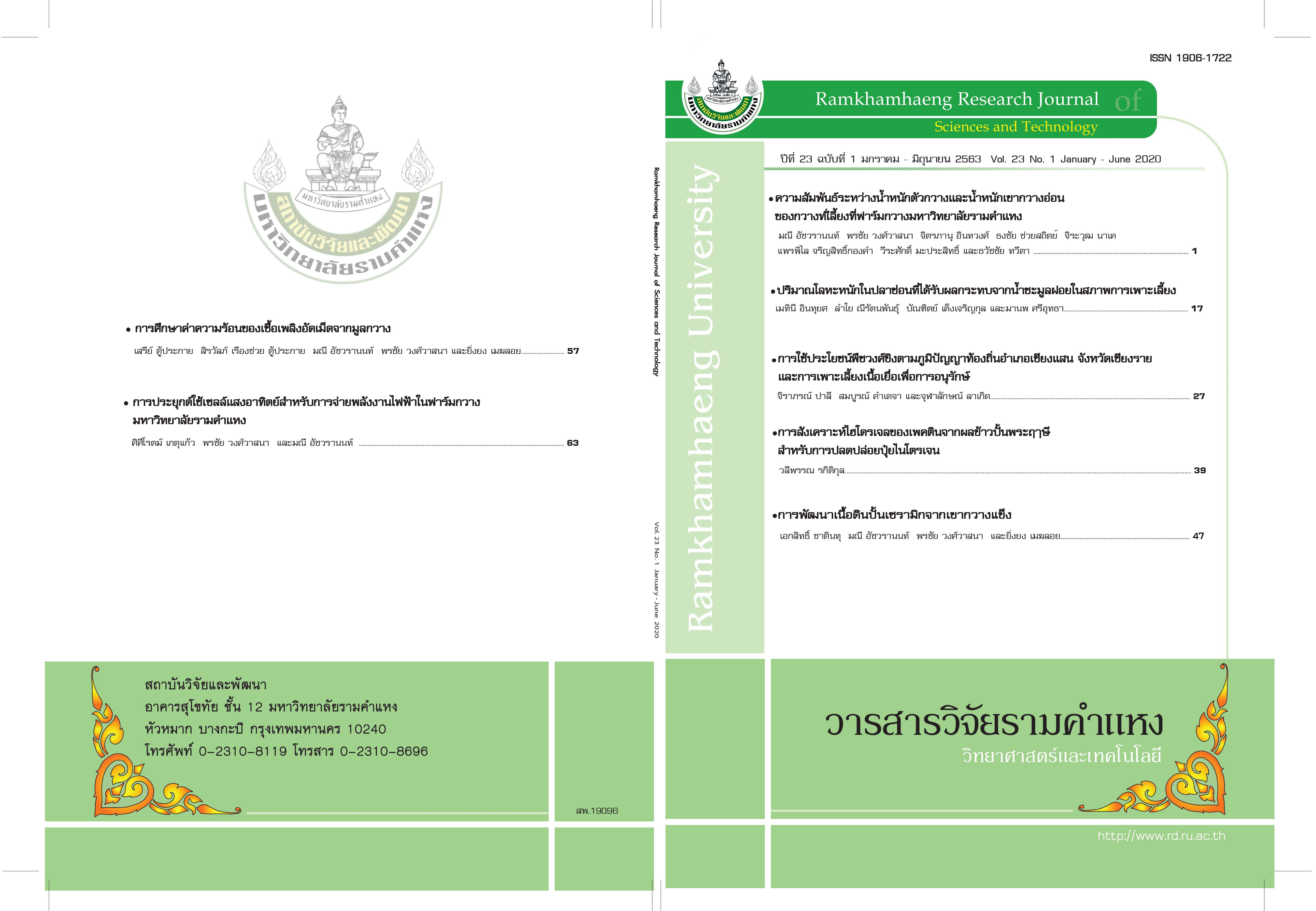The Utilization of the Family Zingiberaceae Based on Local Wisdom in Chiang Saen District, Chiang Rai Province and its Micropropagation for Conservation
Main Article Content
Abstract
In this study, the researchers survey the utilization of the family zingiberaceae based on local wisdom in Chiang Saen district, Chiang Rai province. The researchers also study the micropropagation of these medicinal plants for their conservation and sustainable utilization. The survey to collect data was conducted from February to April 2019 by interviewing well-informed local persons. The survey found that twenty-three species from six genera of Zingiberaceae plants were used. Curcuma was the most utilized genus (seven species) of medicinal plants, followed by Zingiber (six species). Rizome was the main plant part used in traditional medicine. Most of the utilization was for gastrointestinal disorder treatments for carminative, gastritis, flatulence, and others. For the micropropagation of Zingiberaceae plants, an initial study was conducted to find an appropriate method for surface sterilization. The researchers selected the two species of Zingiberaceae plants most utilized by local villagers: Wan Maha Sane (Curcuma sp.) and Nan Thao Wang Haeng (Kaempferia angustifolia). The bud explants of both species were surface-sterilized with different concentrations of the surface disinfectant, Haiter@ (6 percent w/w sodium hypochlorite) and for different time periods. Then, both species of bud explants were cultured on MS agar medium for eight weeks. The results showed that the best disinfection method for Curcuma sp. was a ten percent concentration of the Haiter solution for fifteen minutes which resulted in the highest survival rate of 86.0 percent. The surface disinfection of K. angustifolia using a ten percent concentration of the Haiter solution for ten minutes was the best method as it resulted in the highest survival rate of 63.4 percent.
Article Details
Ramkhamhaeng University
References
จิราภรณ์ ปาลี. 2016. การขยายพันธุ์ต้นลิงลาว (Tupistra albiflora K. Larsen) ในสภาพธรรมชาติและการเพาะเลี้ยงเนื้อเยื่อ. Sci. & Tech. RMUTT J. 6 (2): 1 - 16.
จันทร์เพ็ญ ใจซื่อ, สุรพล ฐิติธนากุล, สรายุทธ อ่อนสนิทและเยาวพรรณ สนธิกุล. 2562. เทคนิคการฟอกฆ่าเชื้อชิ้นส่วนต้นหม้อข้าวหม้อแกงลิงจากธรรมชาติเพื่อการเพาะเลี้ยงเนื้อเยื่อ. KHON KAEN AGR. J. 47 (SUPPL. 1): 1515 – 1520.
จรัญ มากน้อย และพวงเพ็ญ ศิริรักษ์. 2555. พืชสกุลขมิ้นในประเทศไทย. วนิดาการพิมพ์,เชียงใหม่.
นงนุช เลาหะวิสุทธิ์, อัจฉรี เรืองเดช, สมเกียรติ สีสนอง และสมชาย หวังวิบูลย์กิจ. 2560.
ผลของสารฟอกฆ่าเชื้อและสารควบคุมการเจริญเติบโตในการเพาะเลี้ยงเนื้อเยื่อ
พรรณไม้น้ำบูเซป Bucephalandra sp. วารสารเกษตรพระจอมเกล้า. 35 (2):
95 – 103.
นิพิจ พินิจผล และพีระศักดิ์ ฉายประสาท. 2551.
การเพาะเลี้ยงเนื้อเยื่อกล้วยน้ำว้ามะลิอ่อง. Agricultural Sci. J. 39 (3) (Suppl): 116 - 119.
ภพเก้า พุทธรักษ์ และวารุต อยู่คง. 2555. การขยายพันธุ์โมกพวง พุดจีบ รักขาว และรักม่วง โดยเทคนิคการเพาะเลี้ยงเนื้อเยื่อ. วารสารมหาวิทยาลัยศรีนครินทรวิโรฒ (สาขาวิทยาศาสตร์และเทคโนโลยี). 4 (7): 91 - 103.
ภพเก้า พุทธรักษ์, วารุต อยู่คง และมณฑล สงวนเสริมศรี. 2554. การขยายพันธุ์ว่านสี่ทิศโดยการเพาะเลี้ยงเนื้อเยื่อในสภาพปลอดเชื้อ. วารสารนเรศวรพะเยา. 4 (3): 3 - 8.
รุ่งอรุณ ดอนจันทร์ทอง, ณ. นพชัย ชาญศิลป์, สรรลาภ สงวนดีกุล และณัฐวุฒิ รอดบุตร. 2560.
การเพาะเลี้ยงเนื้อเยื่อบัวยักษ์ออสเตรเลีย (Nymphaea gigantea). วารสารวิจัย. 10 (2): 1 - 7.
รัตนา ขามฤทธิ์ และจิตรกร ปรีแม่น. 2562. การฟอกฆ่าเชื้อที่ผิวและการชักนำให้เกิดต้นจาก
ไรโซมของไพลในหลอดทดลอง. แก่นเกษตร. 47 ฉบับพิเศษ 1: 1393 - 1398.
สำนักงานหอพรรณไม้. 2557. ชื่อพรรณไม้แห่งประเทศไทย เต็ม สมิตินันท์ ฉบับแก้ไขเพิ่มเติม พ.ศ. 2557. กรุงเทพฯ: สำนักงานหอพรรณไม้ สำนักวิจัยการอนุรักษ์ป่าไม้และพันธุ์พืช กรมอุทยานแห่งชาติ สัตว์ป่า และพันธุ์พืช.
อุบล สมทรง. 2556. การเพาะเลี้ยงเนื้อเยื่อส้มซ่า (Citrus medica L. var. linetta Risso). วารสารเกษตรพระวรุณ. 10: 29 - 38.
อรุณี ม่วงแก้วงาม. 2557. ผลของสารควบคุมการเจริญเติบโตต่อการเพาะเลี้ยงเนื้อเยื่อดาหลา (Etlingera elatior). Songklanakarin J. Pl. Sci. 1 (1): 10 - 13.
Chotigamas, T., Sripaoraya, S., Gateprasert, M., Vanichsriratana, W. and Sirisansaneeyakul,
S. 2009. The Tissue Culture Optimization for Amorphophallus oncophyllus Cell suspension for Konjac Glucomannan Production. Retrieved from https://pdfs.semanticscholar.org/b630/
2c901230d8164b59686411fce18d1764d8b7.pdf
Chuakul, W. and Boonpleng, A. 2546. Ethnomedical Uses of Thai Zingiberaceous Plant (1). วารสารสมุนไพร. 10 (1): 33 - 39.
Jantan, I.B., Yassin, M.S.M., Chin, C.B., Chen, L.L. and Sim, N.L. 2003. Antifungal Activity of the Essential Oils of Nine Zingiberaceae Species. Pharm. Biol. 41 (5): 392 - 397.
Kaewsri, W. 2006. Systematic Studies of the Genus Amomum Roxb. (Zingiberaceae) in Thailand. Thesis for the Degree of Doctor of Philosophy (Horticulture). Kasetsart University.
Kress, W.J., Prince, L.M. and Williams, K.J. 2002. The Phylogeny and a New Classification of the Gingers (Zingiberaceae): Evidence from Molecular Data. Am. J. Bot. 89 (10): 1682 - 1696.
Larsen, K. and Larsen, S.S. 2006. Gingers of Thailand. Queen Siriki Botanic Garden. Chiang Mai. p.184.
Palee, J., Dheeranupattana, S., Jatisatienr, A. and
Wangkarn, S. 2013. Effects of BA and NAA on Micropropagation and Stemona Alkaloids Production of Stemona curtisii Hook.f. CHIANG MAI J SCI 40 (3):
356 – 363.
Saensouk, S. 2006. Taxonomy and Biology of the Genus Alpinia Roxb. (Zingiberaceae) in Thailand. Thesis for the Degree of Doctor of Philosophy. Khon Kaen University.
Sirirugsa, P. 1989. The Genus Kaempferia (Zingiberaceae) in Thailand. Nordic Journal of Botany. 9: 256 - 260.
Sirirugsa, P. 1992a. A Revision of the Genus Boesenbergia (Zingiberaceae) in Thailand. Natural History Bulletin of the Siam Society. 40: 67 - 90.
Sirirugsa, P. 1992b. Taxonomy of the Genus Kaempferia (Zingiberaceae) in Thailand. Thai Forest Bulletin (Botany). 19: 1 - 15.
Sirirugsa, P., Larsen, K. and Maknoi, C. 2007. The Genus Curcuma L. (Zingiberaceae): Distribution and Classification with Reference to Species Diversity in Thailand. Gardens’ Bulletin Singapore. 59: 203 - 220.
Sirirugsa, P. 1998. Thai Zingiberaceae: Species Diversity and Their Uses. Pure Appl. Chem. 70 (11): 2111 - 2118.
Theilade, I. 1999. A Synopsis of the Genus Zingiber (Zingiberaceae) in Thailand. Nordic Journal of Botany. 19: 389 - 410.
Triboun, P. 2006. Biogeography and Biodiversity of the Genus Zingiber in Thailand. Thesis for the Degree of Doctor of Philosophy. Khon Kaen University.
Udomthanadech, K., Vajrodaya, S. and Paisooksantivatana, Y. 2015. Antibacterial Properties of the Extracts from some Zingibereous Species in Thailand Against Bacteria Causing Diarrhea and Food Poisoning in Human. Int Trans J Eng Manage Appl Sci Technol. 6(5): 203 – 213.Voravuthikunchai, S.P. 2007. Family Zingiberaceae Compounds as Functional Antimicrobials, Antioxidants, and Antiradicals. Food 1 (2): 227 - 240.


